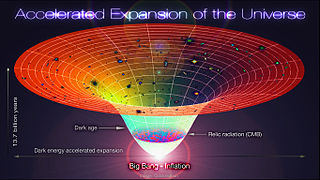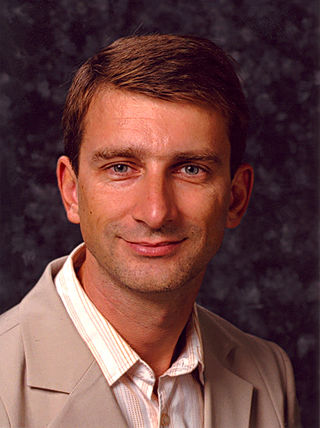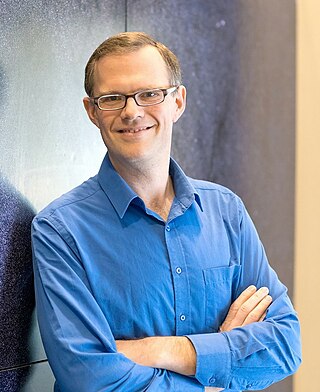
The Big Bang is a physical theory that describes how the universe expanded from an initial state of high density and temperature. It was first proposed in 1927 by Roman Catholic priest and physicist Georges Lemaître. Various cosmological models of the Big Bang explain the evolution of the observable universe from the earliest known periods through its subsequent large-scale form. These models offer a comprehensive explanation for a broad range of observed phenomena, including the abundance of light elements, the cosmic microwave background (CMB) radiation, and large-scale structure. The overall uniformity of the universe, known as the flatness problem, is explained through cosmic inflation: a sudden and very rapid expansion of space during the earliest moments. However, physics currently lacks a widely accepted theory of quantum gravity that can successfully model the earliest conditions of the Big Bang.

Physical cosmology is a branch of cosmology concerned with the study of cosmological models. A cosmological model, or simply cosmology, provides a description of the largest-scale structures and dynamics of the universe and allows study of fundamental questions about its origin, structure, evolution, and ultimate fate. Cosmology as a science originated with the Copernican principle, which implies that celestial bodies obey identical physical laws to those on Earth, and Newtonian mechanics, which first allowed those physical laws to be understood.

In physical cosmology, the Copernican principle states that humans, on the Earth or in the Solar System, are not privileged observers of the universe, that observations from the Earth are representative of observations from the average position in the universe. Named for Copernican heliocentrism, it is a working assumption that arises from a modified cosmological extension of Copernicus' argument of a moving Earth.

The cosmic microwave background is microwave radiation that fills all space in the observable universe. It is a remnant that provides an important source of data on the primordial universe. With a standard optical telescope, the background space between stars and galaxies is almost completely dark. However, a sufficiently sensitive radio telescope detects a faint background glow that is almost uniform and is not associated with any star, galaxy, or other object. This glow is strongest in the microwave region of the radio spectrum. The accidental discovery of the CMB in 1965 by American radio astronomers Arno Penzias and Robert Wilson was the culmination of work initiated in the 1940s.
In astronomy, dark matter is a hypothetical form of matter that appears not to interact with light or the electromagnetic field. Dark matter is implied by gravitational effects which cannot be explained by general relativity unless more matter is present than can be seen. Such effects occur in the context of formation and evolution of galaxies, gravitational lensing, the observable universe's current structure, mass position in galactic collisions, the motion of galaxies within galaxy clusters, and cosmic microwave background anisotropies.

Galaxy groups and clusters are the largest known gravitationally bound objects to have arisen thus far in the process of cosmic structure formation. They form the densest part of the large-scale structure of the Universe. In models for the gravitational formation of structure with cold dark matter, the smallest structures collapse first and eventually build the largest structures, clusters of galaxies. Clusters are then formed relatively recently between 10 billion years ago and now. Groups and clusters may contain ten to thousands of individual galaxies. The clusters themselves are often associated with larger, non-gravitationally bound, groups called superclusters.

Observations show that the expansion of the universe is accelerating, such that the velocity at which a distant galaxy recedes from the observer is continuously increasing with time. The accelerated expansion of the universe was discovered in 1998 by two independent projects, the Supernova Cosmology Project and the High-Z Supernova Search Team, which used distant type Ia supernovae to measure the acceleration. The idea was that as type Ia supernovae have almost the same intrinsic brightness, and since objects that are farther away appear dimmer, the observed brightness of these supernovae can be used to measure the distance to them. The distance can then be compared to the supernovae's cosmological redshift, which measures how much the universe has expanded since the supernova occurred; the Hubble law established that the farther away that an object is, the faster it is receding. The unexpected result was that objects in the universe are moving away from one another at an accelerating rate. Cosmologists at the time expected that recession velocity would always be decelerating, due to the gravitational attraction of the matter in the universe. Three members of these two groups have subsequently been awarded Nobel Prizes for their discovery. Confirmatory evidence has been found in baryon acoustic oscillations, and in analyses of the clustering of galaxies.

The Wilkinson Microwave Anisotropy Probe (WMAP), originally known as the Microwave Anisotropy Probe, was a NASA spacecraft operating from 2001 to 2010 which measured temperature differences across the sky in the cosmic microwave background (CMB) – the radiant heat remaining from the Big Bang. Headed by Professor Charles L. Bennett of Johns Hopkins University, the mission was developed in a joint partnership between the NASA Goddard Space Flight Center and Princeton University. The WMAP spacecraft was launched on 30 June 2001 from Florida. The WMAP mission succeeded the COBE space mission and was the second medium-class (MIDEX) spacecraft in the NASA Explorer program. In 2003, MAP was renamed WMAP in honor of cosmologist David Todd Wilkinson (1935–2002), who had been a member of the mission's science team. After nine years of operations, WMAP was switched off in 2010, following the launch of the more advanced Planck spacecraft by European Space Agency (ESA) in 2009.
The ultimate fate of the universe is a topic in physical cosmology, whose theoretical restrictions allow possible scenarios for the evolution and ultimate fate of the universe to be described and evaluated. Based on available observational evidence, deciding the fate and evolution of the universe has become a valid cosmological question, being beyond the mostly untestable constraints of mythological or theological beliefs. Several possible futures have been predicted by different scientific hypotheses, including that the universe might have existed for a finite and infinite duration, or towards explaining the manner and circumstances of its beginning.

The observable universe is a ball-shaped region of the universe consisting of all matter that can be observed from Earth or its space-based telescopes and exploratory probes at the present time; the electromagnetic radiation from these objects has had time to reach the Solar System and Earth since the beginning of the cosmological expansion. Initially, it was estimated that there may be 2 trillion galaxies in the observable universe. That number was reduced in 2021 to only several hundred billion based on data from New Horizons. Assuming the universe is isotropic, the distance to the edge of the observable universe is roughly the same in every direction. That is, the observable universe is a spherical region centered on the observer. Every location in the universe has its own observable universe, which may or may not overlap with the one centered on Earth.
The Sunyaev–Zeldovich effect is the spectral distortion of the cosmic microwave background (CMB) through inverse Compton scattering by high-energy electrons in galaxy clusters, in which the low-energy CMB photons receive an average energy boost during collision with the high-energy cluster electrons. Observed distortions of the cosmic microwave background spectrum are used to detect the disturbance of density in the universe. Using the Sunyaev–Zeldovich effect, dense clusters of galaxies have been observed.

In the fields of Big Bang theory and cosmology, reionization is the process that caused electrically neutral atoms in the universe to reionize after the lapse of the "dark ages".
In physical cosmology, the age of the universe is the time elapsed since the Big Bang. Astronomers have derived two different measurements of the age of the universe: a measurement based on direct observations of an early state of the universe, which indicate an age of 13.787±0.020 billion years as interpreted with the Lambda-CDM concordance model as of 2021; and a measurement based on the observations of the local, modern universe, which suggest a younger age. The uncertainty of the first kind of measurement has been narrowed down to 20 million years, based on a number of studies that all show similar figures for the age. These studies include researches of the microwave background radiation by the Planck spacecraft, the Wilkinson Microwave Anisotropy Probe and other space probes. Measurements of the cosmic background radiation give the cooling time of the universe since the Big Bang, and measurements of the expansion rate of the universe can be used to calculate its approximate age by extrapolating backwards in time. The range of the estimate is also within the range of the estimate for the oldest observed star in the universe.
The Lambda-CDM, Lambda cold dark matter, or ΛCDM model is a mathematical model of the Big Bang theory with three major components:
- a cosmological constant denoted by lambda (Λ) associated with dark energy
- the postulated cold dark matter denoted by CDM
- ordinary matter

The Dark Energy Survey (DES) is an astronomical survey designed to constrain the properties of dark energy. It uses images taken in the near-ultraviolet, visible, and near-infrared to measure the expansion of the universe using Type Ia supernovae, baryon acoustic oscillations, the number of galaxy clusters, and weak gravitational lensing. The collaboration is composed of research institutions and universities from the United States, Australia, Brazil, the United Kingdom, Germany, Spain, and Switzerland. The collaboration is divided into several scientific working groups. The director of DES is Josh Frieman.
In physical cosmology and astronomy, dark energy is an unknown form of energy that affects the universe on the largest scales. Its primary effect is to drive the accelerating expansion of the universe. Assuming that the lambda-CDM model of cosmology is correct, dark energy is the dominant component of the universe, contributing 68% of the total energy in the present-day observable universe while dark matter and ordinary (baryonic) matter contribute 26% and 5%, respectively, and other components such as neutrinos and photons are nearly negligible. Dark energy's density is very low: 6×10−10 J/m3, much less than the density of ordinary matter or dark matter within galaxies. However, it dominates the universe's mass–energy content because it is uniform across space.
In cosmology, baryon acoustic oscillations (BAO) are fluctuations in the density of the visible baryonic matter of the universe, caused by acoustic density waves in the primordial plasma of the early universe. In the same way that supernovae provide a "standard candle" for astronomical observations, BAO matter clustering provides a "standard ruler" for length scale in cosmology. The length of this standard ruler is given by the maximum distance the acoustic waves could travel in the primordial plasma before the plasma cooled to the point where it became neutral atoms, which stopped the expansion of the plasma density waves, "freezing" them into place. The length of this standard ruler can be measured by looking at the large scale structure of matter using astronomical surveys. BAO measurements help cosmologists understand more about the nature of dark energy by constraining cosmological parameters.

In cosmology, the steady-state model or steady state theory is an alternative to the Big Bang theory. In the steady-state model, the density of matter in the expanding universe remains unchanged due to a continuous creation of matter, thus adhering to the perfect cosmological principle, a principle that says that the observable universe is always the same at any time and any place.

Uroš Seljak is a Slovenian cosmologist and a professor of astronomy and physics at University of California, Berkeley. He is particularly well-known for his research in cosmology and approximate Bayesian statistical methods.

Peter Lawrence Capak is currently the Architect of Perception Systems at the Oculus division of Facebook. His current focus is developing machine perception technologies, sensors, displays, and compute architectures for the next generation of augmented (AR), mixed (MR) and virtual reality (VR) systems. His research has focused on using physical modeling and advanced statistical methods including artificial intelligence and machine learning to extract information from very large multi-wavelength (hyper-spectral) data sets. He has primarily used this to study structure formation in the universe, cosmology, and the nature of dark matter and dark energy.












